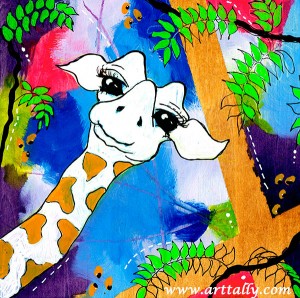Fun facts about the giraffe
 Whenever I pick a subject to draw and paint in a series like this, one of my favourite things to do is to investigate the subject a little further. Totally nerd up the whole process.
Whenever I pick a subject to draw and paint in a series like this, one of my favourite things to do is to investigate the subject a little further. Totally nerd up the whole process.
With the giraffe, that research process has been well worth while. Check out these fun facts about the giraffe:
- giraffes only need 5-30 minutes sleep per day. They often take little naps that last only a minute or two, and can rest standing up
- the lungs of the giraffe hold 55 litres of air
- a giraffe's heart is 0.6m long and weighs 11 kg. It is the largest of any land mammal.
- NASA did research on the valves in the blood vessels of the giraffe to aid in the design of space suits. In order to protect the giraffe’s brain from sudden changes in blood pressure when it lowers its head to drink, it has valves to stop the back-flow of blood and elastic-walled vessels that dilate and constrict to manage flow
- the giraffe has a blue-purple tongue that is 53cm (21 inches) long. It is thought that this dark colour on the tip is to protect the tongue from sunburn as it is mostly out gathering leaves.
- the giraffe’s tongue has thickened papillae, which helps to protect it from the vicious thorns of the Acacia tree that it favours. In addition, thick saliva is also believed to help to protect the giraffe’s tongue and mouth against the defensive mechanisms of their favourite food.
- giraffes eat most of the time, chewing the cud like cows do and eat about 34kg of leaves per day
- despite its significant length, the giraffe's neck is not long enough to reach the ground so in order to drink so it has to kneel or spread its front legs
- although some people think that the giraffe does not make a noise, it can moo, grunt, hiss and snort - it just usually chooses not to. Studies also suggest that giraffe can communicate with sounds that are below the level of human hearing.
- the beautiful patterns on the giraffe are designed to camouflage them in the African plains. Like fingerprints, no two giraffe have identical markings.
- the giraffe species name is Giraffa camelopardalis because it has a small hump between its neck and its back and can go for many days without drinking like a camel, and because its markings are similar to the leopards 'spots'.
If you have still not had enough of giraffes, you might want to head over to the National Geographic website to check out a range of photos and facts about the awesome giraffe. You might also enjoy the comprehensive information from the San Diego Zoo over here.
